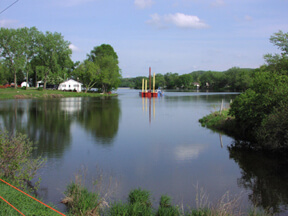
CSWAB photograph of Gruber’s Grove Bay & dredger
In a June 7 letter to Citizens for Safe Water Around Badger (CSWAB), the Wisconsin DNR said it has found mercury concentrations more than 25 times the required cleanup goal and almost 400 times higher than levels reported by the Army in sediments at Gruber’s Grove Bay on Lake Wisconsin. The sediment contamination was caused by the historical discharge of sanitary and industrial wastewater from Badger Army Ammunition Plant directly to the river.
Despite a second multi-million dollar cleanup effort by the Army last summer, 8 of the 10 sediment samples tested by the WDNR exceeded the cleanup goal of 0.36 parts per million (ppm). WDNR test results for mercury ranged from 0.24 to more than 9 ppm. Army contractors tested 65 sediment samples from the same areas of the bay and reported that all were well below the required cleanup goal; their results ranged from 0.006 to 0.34 ppm.
“The results are shocking and disappointing,” said Laura Olah, Executive Director of CSWAB. “Mercury is a powerful environmental toxin that affects the health of the river and our fisheries. Leaving mercury in the bay is not an option.”
Ironically, the WDNR tested bay sediment to meet requirements of the Clean Water Act and not to validate the Army’s results. The state was hoping to have the bay removed from the federal Impaired Waters List following the Army’s recent $6 million dredging effort.
The WDNR said that they are in the process of gathering more information to explain the significant discrepancies in test results. An evaluation of both the Army’s and WDNR’s sampling and laboratory procedures was conducted by two separate reviewers, the WDNR told CSWAB. No inadequacies were identified, state officials said.
The campaign for cleanup of mercury, chromium, lead, naphthalene, and other toxins in bay sediments was led by CSWAB, a community-led organization that has been working for more than 17 years to assure a healthy and sustainable future for the Badger lands.
The WDNR previously described the Lake Wisconsin bay as “one of the worst localized mercury contaminant sediment situations that we know about on a state-wide basis.” State officials promised to keep CSWAB and local residents informed with new information as it becomes available.
June 25, 2007 WDNR letter regarding discrepancies in sediment sampling results (.pdf file)
WDNR-prepared map comparing Army and WDNR test results for mercury (.pdf file)

